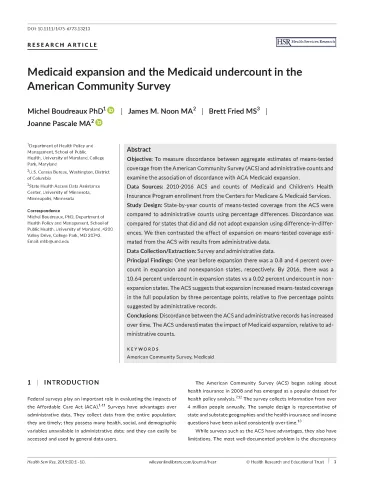Researchers at SHADAC have long been interested in the issue of “Medicaid undercount,” or the discrepancies that exist between survey estimates of enrollment in Medicaid and the number of enrollees that are actually reported in state and national administrative data—a pattern in which the former estimate is reported consistently lower than the latter. Studies on the subject have shown that nearly all surveys undercount Medicaid/CHIP relative to administrative sources, but the magnitude of the undercount range can vary broadly between major federal surveys (e.g., the American Community Survey, the Current Population Survey, the Medical Expenditure Panel Survey, etc.).
A new paper from researchers Michel Boudreaux (University of Maryland), Brett Fried (SHADAC), James Noon, and Joanna Pascale (U.S. Census Bureau), is the latest in a series of projects and publications that look at the differing enrollment measurements found between the American Community Survey (ACS) and the Medicaid and CHIP data provided by the Centers for Medicare and Medicaid Services (CMS) in order to gauge the degree of difference. In this latest article, the authors not only compare measurements from the survey with administrative data but also, in a first-of-its-kind study, cross-compare measurements between states that either did or did not adopt Medicaid expansion.
Federal surveys vs. administrative data
As noted in the article’s introduction, federal surveys have a multiplicity of useful features regarding data evaluation (e.g., broad population sources, timeliness, detail at a variety of geographic and demographic levels, availability, etc.). The ACS in particular, is an excellent source of such data, as it collects information from a large sample size (over 4 million people annually) representative of state and sub-state geographies, and the health insurance and income questions are asked with consistency.[1]
Additionally, the ACS is a notable exception to the undercounting of Medicaid/CHIP as Boudreaux and a team of researchers previously published in a paper on the 2009 ACS, which they found actually overcounted Medicaid/CHIP administrative records by 8 percent. One facet to the goals of this study was to measure the discrepancies between the ACS and administrative data over time (using data years 2010-2016) and investigate whether the 2009 ACS overcount has persisted.
The role of Medicaid expansion
Another facet was the possibility of discerning any patterns in discrepancies between ACS and Medicaid/CHIP enrollment data with regard to state decisions to adopt Medicaid expansion, or not. Higher undercounting as a result of Medicaid expansion could be possible, the authors theorized, for a number of reasons, including:
- Eligibility increase among populations less likely to report Medicaid coverage, such as adults and higher income individuals.
- Insurance marketplace portals that do not clarify exact source of coverage for individuals enrolling in Medicaid/CHIP.
- Lack of adequate specificity in source of coverage questions in the ACS.
Conclusions
Merging state and administrative data allowed the researchers to produce estimates for years 2013, 2014, 2015, and 2016 at a state level, which were then divided into several subgroups: All states, Nonexpansion states, Early expansion states, 2014 expansion states, and Late expansion states.
Results from each group varied, with years of both over- and undercount recorded, but overall showed a few consistent patterns. First, that among almost all groups (with the exception of “Nonexpansion states”) the ACS reversed course starting in 2013 and began to almost consistently undercount Medicaid/CHIP enrollment. And second, that the degree of discrepancy tended to increase each year from 2013 to 2016, though the degree of increase varied from group to group (lower for “All states” vs. higher for “Late expansion states”).
Overall, the authors concluded, Medicaid expansion did affect measurements from the ACS, with discrepancies between survey and administrative data increasing in years (and states) surrounding expansion. However, they did note that the degree of discrepancy in the ACS (7.9 percent) was much smaller when compared to other surveys (22.0 percent in the CPS and NHIS), suggesting that continual investments and revisions to survey systems, such as the recent redesign of the CPS, may continue to help reduce these discrepancies.
Read the full article for more detail on the data and methodology used in the paper, as well as discussion of the results and implications for surveys.
Related Reading
The Medicaid Undercount Project
Accuracy of Self-reported Health Insurance Coverage among Medicaid Enrollees
The Medicaid Undercount: Synthesis of Research
Uncovering the Missing Medicaid Cases and Assessing Their Bias for Estimates of the Uninsured
Notes
[1] See the annual “Comparing Federal Government Surveys that Count the Uninsured: 2019” brief for more details on features and differences of federal surveys and guidance on when to use data from each one.

